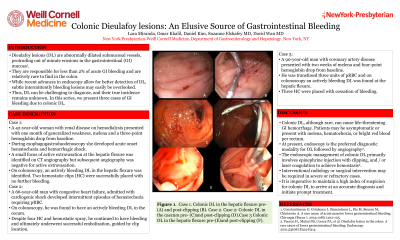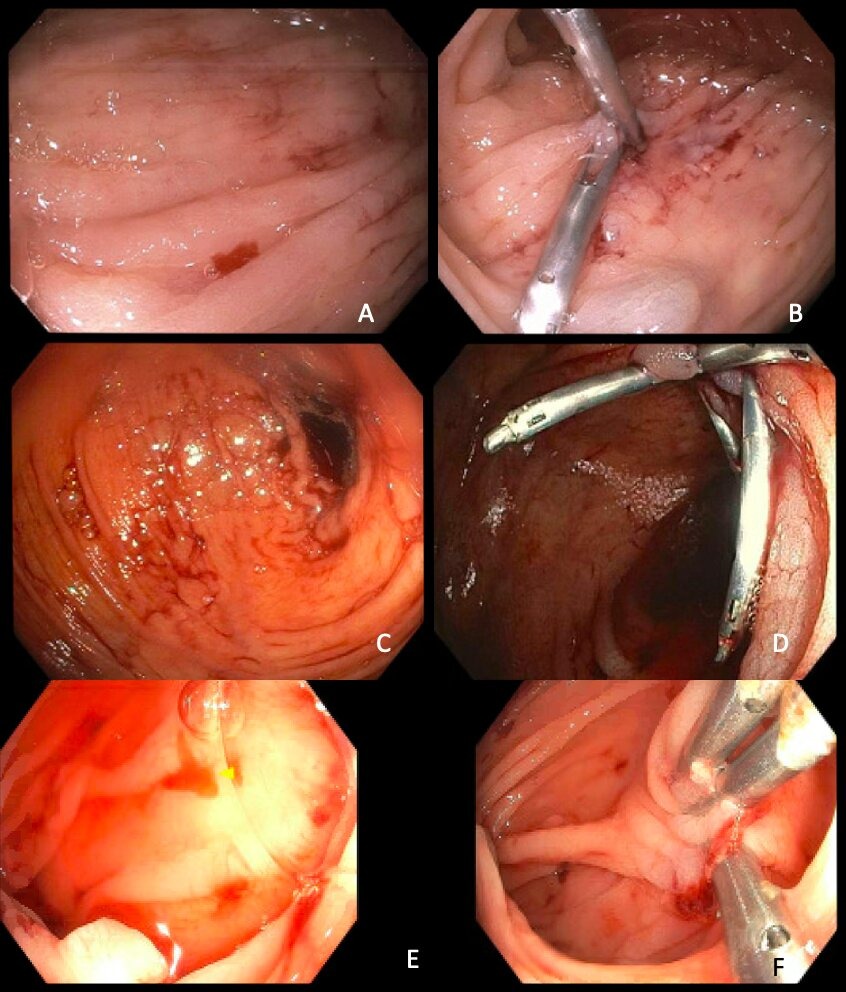Back


Poster Session B - Monday Morning
Category: GI Bleeding
B0339 - Colonic Dieulafoy’s Lesions: An Elusive Source of Gastrointestinal Bleeding
Monday, October 24, 2022
10:00 AM – 12:00 PM ET
Location: Crown Ballroom

Has Audio
- LM
Lara Miranda
Weill Cornell Medical College
Manhattan, NY
Presenting Author(s)
Lara Miranda, 1, Omar Khalil, 1, Daniel Kim, 1, Suzanne Elshafey, MD2, David Wan, MD3
1Weill Cornell Medical College, Manhattan, NY; 2New York Presbyterian-Weill Cornell Medical Center, Manhattan, NY; 3New York-Presbyterian Hospital/Weill Cornell Medicine, New York, NY
Introduction: Dieulafoy’s lesions (DL) are abnormally dilated submucosal vessels, protruding out of minute erosions in the gastrointestinal (GI) mucosa. They are responsible for less than 2% of acute GI bleeding and are relatively rare to find in the colon. While recent advances in endoscopy allow for better detection of DL, subtle intermittently bleeding lesions may easily be overlooked. Thus, DL can be challenging to diagnose, and its true incidence remains unknown. In this series, we present three cases of GI bleeding due to colonic DL.
Case Description/Methods: Case 1: A 42-year-old woman with renal disease on hemodialysis presented with one month of generalized weakness, melena, and a three-point hemoglobin drop from baseline. During esophagogastroduodenoscopy, she developed acute onset hematochezia and hemorrhagic shock. A small focus of active extravasation at the hepatic flexure was identified on CT angiography but subsequent angiography performed by interventional radiology was negative for active extravasation. On colonoscopy, an actively bleeding DL in the hepatic flexure was identified. Two hemostatic clips (HC) were successfully placed with no further bleeding.
Case 2: A 66-year-old man with congestive heart failure, admitted with cardiogenic shock developed intermittent episodes of hematochezia requiring packed red blood cells (pRBC). On colonoscopy, he was found to have an actively bleeding DL at the cecum. Despite four HC and hemostatic spray, his bleeding persisted, and he underwent successful embolization, guided by clip location.
Case 3: A 90-year-old man with coronary artery disease presented with two weeks of melena and a four-point hemoglobin drop from baseline. He was transfused three units of pRBC and on colonoscopy, an actively bleeding DL was found at the hepatic flexure. Three HC were placed with cessation of bleeding.
Discussion: Colonic DL, although rare, can cause life-threatening GI hemorrhage. Patients may be asymptomatic or present with melena, hematochezia, or bright red blood per rectum. At present, endoscopy is the preferred diagnostic modality for DL followed by angiography. The endoscopic management of colonic DL primarily involves epinephrine injection, clipping, and/or laser coagulation to achieve hemostasis. Interventional radiology or surgical intervention may be required in severe or refractory cases.
It is imperative to maintain a high index of suspicion for colonic DL to arrive at an accurate diagnosis and initiate prompt treatment.

Disclosures:
Lara Miranda, 1, Omar Khalil, 1, Daniel Kim, 1, Suzanne Elshafey, MD2, David Wan, MD3. B0339 - Colonic Dieulafoy’s Lesions: An Elusive Source of Gastrointestinal Bleeding, ACG 2022 Annual Scientific Meeting Abstracts. Charlotte, NC: American College of Gastroenterology.
1Weill Cornell Medical College, Manhattan, NY; 2New York Presbyterian-Weill Cornell Medical Center, Manhattan, NY; 3New York-Presbyterian Hospital/Weill Cornell Medicine, New York, NY
Introduction: Dieulafoy’s lesions (DL) are abnormally dilated submucosal vessels, protruding out of minute erosions in the gastrointestinal (GI) mucosa. They are responsible for less than 2% of acute GI bleeding and are relatively rare to find in the colon. While recent advances in endoscopy allow for better detection of DL, subtle intermittently bleeding lesions may easily be overlooked. Thus, DL can be challenging to diagnose, and its true incidence remains unknown. In this series, we present three cases of GI bleeding due to colonic DL.
Case Description/Methods: Case 1: A 42-year-old woman with renal disease on hemodialysis presented with one month of generalized weakness, melena, and a three-point hemoglobin drop from baseline. During esophagogastroduodenoscopy, she developed acute onset hematochezia and hemorrhagic shock. A small focus of active extravasation at the hepatic flexure was identified on CT angiography but subsequent angiography performed by interventional radiology was negative for active extravasation. On colonoscopy, an actively bleeding DL in the hepatic flexure was identified. Two hemostatic clips (HC) were successfully placed with no further bleeding.
Case 2: A 66-year-old man with congestive heart failure, admitted with cardiogenic shock developed intermittent episodes of hematochezia requiring packed red blood cells (pRBC). On colonoscopy, he was found to have an actively bleeding DL at the cecum. Despite four HC and hemostatic spray, his bleeding persisted, and he underwent successful embolization, guided by clip location.
Case 3: A 90-year-old man with coronary artery disease presented with two weeks of melena and a four-point hemoglobin drop from baseline. He was transfused three units of pRBC and on colonoscopy, an actively bleeding DL was found at the hepatic flexure. Three HC were placed with cessation of bleeding.
Discussion: Colonic DL, although rare, can cause life-threatening GI hemorrhage. Patients may be asymptomatic or present with melena, hematochezia, or bright red blood per rectum. At present, endoscopy is the preferred diagnostic modality for DL followed by angiography. The endoscopic management of colonic DL primarily involves epinephrine injection, clipping, and/or laser coagulation to achieve hemostasis. Interventional radiology or surgical intervention may be required in severe or refractory cases.
It is imperative to maintain a high index of suspicion for colonic DL to arrive at an accurate diagnosis and initiate prompt treatment.

Figure: Figure 1: (A) Case 1 Colonic DL in the hepatic flexure (B) Case 1 post-clipping (C) Case 2: Colonic DL in the caecum (D) Case 2 post clipping (E) Case 3 Colonic DL in the hepatic flexure (F) Case 3 post clipping
Disclosures:
Lara Miranda indicated no relevant financial relationships.
Omar Khalil indicated no relevant financial relationships.
Daniel Kim indicated no relevant financial relationships.
Suzanne Elshafey indicated no relevant financial relationships.
David Wan indicated no relevant financial relationships.
Lara Miranda, 1, Omar Khalil, 1, Daniel Kim, 1, Suzanne Elshafey, MD2, David Wan, MD3. B0339 - Colonic Dieulafoy’s Lesions: An Elusive Source of Gastrointestinal Bleeding, ACG 2022 Annual Scientific Meeting Abstracts. Charlotte, NC: American College of Gastroenterology.
